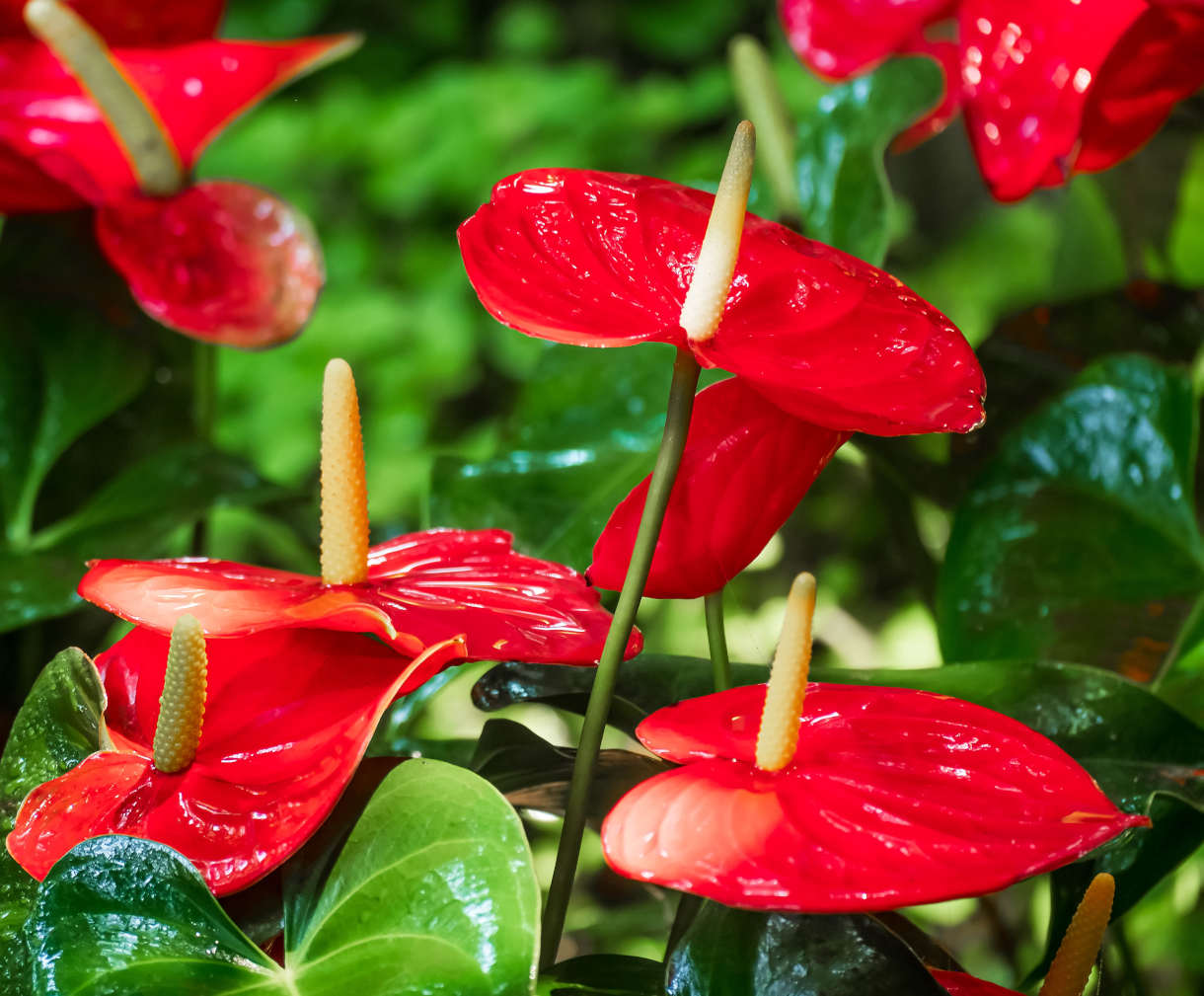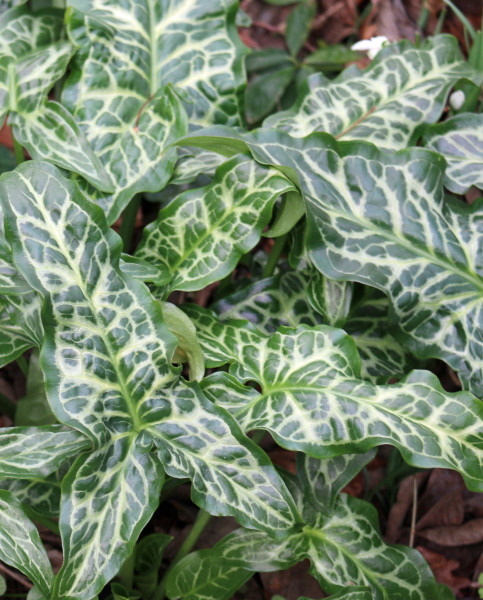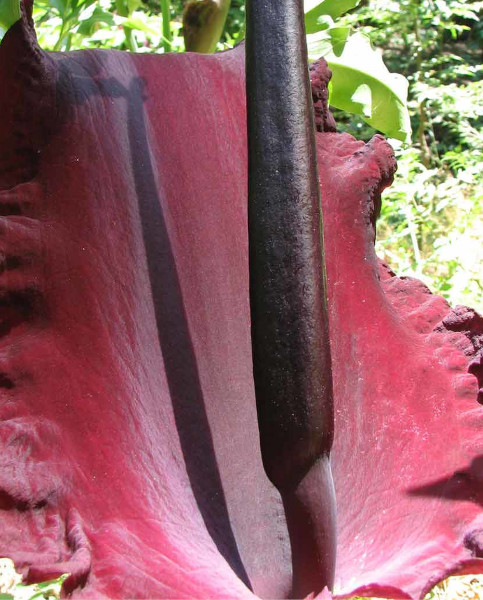How to grow Arum
Also known as lords and ladies, or cuckoo pint, arum is a genus of spring-flowering tuberous perennial found growing in partially shaded spots throughout many parts of the world. It is recognisable for its distinctive and often attractively marked spear, arrow, or heart-shaped leaves, along with unusual flowers which consist of a spadix (spike of tiny flowers) enclosed by a spathe (hood). Once ripe, the spadix heats up and emits a strong, often unpleasant smell to attract insects. Downward facing hairs then trap these at the base of the hooded chamber until the flowers inside have been pollinated.
The leaves are usually produced in autumn or winter, peak during early spring, then wither, along with the spathe, in midsummer. The spadix persists, growing taller and becoming encrusted in red or orange autumn berries. These make an attractive feature in their own right and may last through until the following spring, unless there are hungry blackbirds, thrushes, or pheasants in the vicinity.
The arum species most UK gardeners will be familiar with is Arum maculatum, the native plant seen throughout the countryside in woodland, hedgerows, and ditches. This spreads easily and is likely to become a nuisance if it becomes established in a well-tended garden. That said, it is not without merit – it has great wildlife value and a highly adaptable nature, meaning it can be a good plant to encourage in more inhospitable places (e.g., dry shade) where less vigorous and robust plants may struggle.
Another key species is A. italicum and its cultivars. These are often grown for ornamental value – their leaves being attractively marbled with pale veining. The dramatically marked A. italicum ‘Marmoratum’ is a favourite amongst flower arrangers.
Arum is not to be confused with zantedeschia – a larger and more tender African genus within the same family (araceae), commonly referred to as arum lily.
Amend the soil with compost before planting, as Arum like their soil to be humus-rich. Water thoroughly after planting.

Key Information
Soil pH
Position
Hardiness


Where to plant Arum
Arum can be sold as both bare tubers or pot grown plants.
Whichever type you have, for best results plant in autumn or spring. An autumn planting can be done by those gardening in mild conditions (and broadly speaking, this is the southern half of the UK). For those liable to cold winters, it is best to wait until spring (generally the northern half of the UK). Planting can also be carried out in summer, though be prepared to water regularly.
Bare tubers can either be planted directly into the ground (simply avoid waterlogged or frozen conditions) or started off in pots. The latter enables them to establish without competition from other plants and is a useful approach for densely planted or weed-stricken areas.
Once established, arum is highly tolerant of summer drought, making it a useful plant for tricky, dry spots such as along the base of walls and hedges, on steep banks, or beneath large, thirsty trees. These more challenging situations have the added benefit of keeping in check a natural tendency to spread rapidly.
Arum may also be planted in more favourable conditions, such as in the rich, moist soil of a woodland garden or well-tended border, though here will require more attention to prevent it taking over. This means deadheading before berries have a chance to form, and regularly removing any unwanted seedlings or young plants.
Arum can also be grown in a container, where it makes an easy, low-maintenance source of greenery.
It is worth noting that arum will regrow from even a small fragment of tuber left in the ground, so can be difficult to eradicate once introduced. It is therefore particularly important with this plant to get the planting location right first time, and to avoid putting it on your compost heap (opt for a council green waste bin or another method of offsite disposal instead).
How to plant Arum
- For planting in the garden, dig the soil area removing any large stones and weeds and breaking up any lumps. Mix in some organic matter such as manure or garden compost. Rake level and firm with your heels. Rake level again.
- Water pot grown plants well and allow to drain before planting.
- For pot grown plants, dig a hole twice the size of the root-ball. For bare tubers, dig a small hole aiming for a depth of 10-15cm (though don’t worry too much – arum is very good at adjusting itself to the optimum position in the soil).
- Place pot grown plants in their hole, ensuring the top of the root ball sits level with the surface of the soil. Pop tubers in their hole, growing tip facing upwards.
- Backfill with soil and firm in gently with your foot.
- Soak well with water.
- Mulch around the base with well-rotted organic matter.
- For planting in containers, first choose an appropriately sized pot. You may wish to grow your arum on its own in a pot, or as part of a larger, mixed container display. Either way, ensure there are plenty of drainage holes in the bottom.
- If you are using a large or heavy pot, it can be a good idea to fill and plant it in situ to save yourself the trouble of moving once full.
- Use a good quality potting compost with some horticultural grit mixed in and, if not already present (check the labelling on the bag) some slow-release fertiliser granules.
- Start by partially filling the pot with compost; enough so that when placed on it the upper surface of the pot grown plant’s root ball is about 3cm lower than the top of the pot. Aim for bare tubers to sit at a depth of about 10-15cm.
- Backfill with gritty compost, firming down with your fingers then adding a little more.
- Pick up the container and lightly tap on the potting bench or ground a few times to help further settle the compost around the plant.
- Soak well with water.
- A mulch with horticultural grit will look attractive and help to prevent a ‘cap’ or crust forming on the top of the compost (something container plants can suffer due to the artificial nature of their watering).

How to care for Arum
Pruning and Deadheading
Enjoy the bright berries in late summer and autumn, though remove just as they start to disintegrate to prevent invasive self-seeding.
Other than this, no pruning is required – arum foliage dies back naturally.
Watering
Soak your arum with water a handful of times during its first couple of months in the ground. Allowing the top few centimetres of soil to dry out in between will help avoid overdoing it (wiggle your finger down into the soil to check). After this initial period, arum is drought-tolerant and largely self-sufficient in all but the most prolonged periods of hot, dry weather.
If you are growing arum in a container, remember it has less access to moisture so will need regular watering throughout every growing season. Again, allowing the top couple of centimetres of compost to dry out in between is advised. From mid-autumn, the British climate tends to take over watering needs.
Feeding
Arum is not a hungry plant and so requires no additional feeding when grown in the ground. Having said that, an annual application of mulch (i.e., a layer of well-rotted organic matter such as manure or garden compost spread over the surface of the soil) can be useful in keeping plants looking healthy if they are grown in some of the particularly poor, lean conditions suggested above.
In a container, good quality potting compost with some slow release fertiliser granules mixed in should be enough to support a year’s worth of growth.
Cold Protection
The species of arum discussed in this growing guide are hardy enough to withstand a UK winter without the need for addition al protection.
Pests and Diseases
Arum is considered trouble free.
How to propagate Arum
The quickest and easiest way to propagate arum is through lifting and dividing.
- Dig up established clumps once flowering has finished.
- Tease apart the tubers, carefully by hand.
- Replant or pot up immediately (it’s best not to let them dry out).
- Grow on until large enough to be planted out as per above.
* Many plants carry Plant Breeders Rights and cannot be propagated for commercial purposes.
Common Arum questions
- Is arum poisonous?
All parts of arum are toxic and may cause severe discomfort if ingested. The sap may also irritate skin, therefore gloves are recommended when dealing with this plant.




